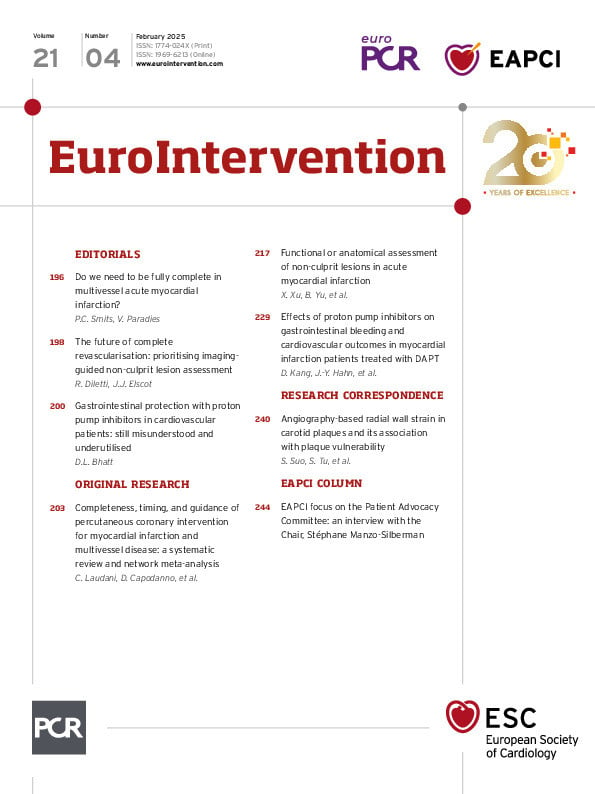Cory:
Unlock Your AI Assistant Now!
Acute coronary syndrome (ACS) remains one of the leading causes of mortality and morbidity, accounting for a ~16% five-year mortality rate due to cardiac causes and a ~14.5% incidence of repeat non-fatal myocardial infarction1. In addition, disease burden due to cardiovascular disease including ACS is increasing because of population ageing in Western countries2. However, developments in the diagnosis and treatment of acute myocardial infarction have played a pivotal role in restraining the increasing cardiac disease burden3. One such development is the shifting paradigm towards complete coronary revascularisation of culprit and non-culprit lesions (NCLs) in patients with ST-segment elevation myocardial infarction, which is currently recommended in the 2023 European guidelines for the management of acute coronary syndromes4. Physiological interrogation of NCLs was confirmed to be a safe approach during the CompareAcute and DANAMI-3-PRIMULTI trials56 . However, the effectiveness of physiology-guided percutaneous coronary intervention (PCI) remains debatable when considering the presence of dynamic results in the setting of acute myocardial infarction78. In addition, NCLs with vulnerable plaque, observed with the use of optical coherence tomography (OCT) or intravascular ultrasonography (IVUS), have a higher risk of causing future adverse events compared with lesions showing stable characteristics, even when the physiological assessment is negative9. Treatment of physiology-negative lesions was demonstrated as a beneficial strategy in the PREVENT trial, though it must be mentioned that this study’s population consisted primarily of patients with stable coronary disease (>80%)10, which raises the question of how to manage patients with acute myocardial infarction (AMI) and NCLs.
In this issue of EuroIntervention, Xu et al11 shed further light on prediction modalities for NCL-related events in patients presenting with AMI. In this retrospective study, 645 patients (with a total of 1,320 NCLs) underwent OCT of all major coronary arteries in addition to physiological assessment with use of Murray fractal law-based quantitative flow ratio (μQFR), the latest iteration of fractional flow reserve calculation with use of a single angiographic film12. Follow-up data were collected for five years for a composite clinical outcome including cardiac death, NCL-related non-fatal myocardial infarction and NCL-related unplanned coronary revascularisation.
The authors demonstrate that OCT-observed thin-cap fibroatheroma (TCFA) remains the best predictor for lesion-level clinical events (adjusted hazard ratio [HR] 4.46, 95% confidence interval [CI]: 2.33-8.56; p<0.001) in contrast to a significant physiological assessment (μQFR ≤0.80) alone (adjusted HR 1.46; 95% CI: 0.71-3.01; p=0.304). Still, it has to be said that the ≤0.80 μQFR group had a low number of participants (n=172) and was potentially underpowered for this comparison. Furthermore, an interesting finding was the astonishingly high incidence of the primary outcome in patients presenting with both μQFR ≤0.80 and OCT-observed TCFA (cumulative incidence 29.6%). The cumulative incidence curve of this subgroup seems to diverge shortly after the revascularisation procedure, suggesting that repeat events in vulnerable NCLs can occur in not just years, but merely weeks or even days following culprit-lesion PCI if left untreated. This finding is supported by the staged complete revascularisation group of the BioVasc trial, which showed a similar increased incidence of cardiac events shortly after culprit PCI in ACS patients when significant NCLs are left untreated13. In conclusion, recent clinical data suggest that patients presenting with AMI often have multiple high-risk coronary artery lesions, and there is increasing evidence advocating for routine imaging-guided complete revascularisation.
Conflict of interest statement
R. Diletti has received institutional research grants from Biotronik, Medtronic, ACIST Medical Systems, and Boston Scientific; and has received speaker fees from Abbott Vascular and Boston Scientific. J.J. Elscot has no conflicts of interest to declare.

